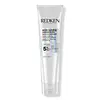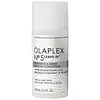What's inside
What's inside
 Key Ingredients
Key Ingredients

No key ingredients
 Benefits
Benefits

 Concerns
Concerns

 Ingredients Side-by-side
Ingredients Side-by-side

Water
Skin ConditioningDimethicone
EmollientCetearyl Alcohol
EmollientAmodimethicone
Phenoxyethanol
PreservativePolyquaternium-37
Dimethiconol
EmollientParfum
MaskingPropylene Glycol Dicaprylate/Dicaprate
EmollientTrideceth-5
EmulsifyingSteareth-20
CleansingCetyl Hydroxyethylcellulose
Emulsion StabilisingGlycerin
HumectantCitric Acid
BufferingLimonene
PerfumingPPG-1 Trideceth-6
Skin ConditioningTrideceth-10
CleansingSodium Hydroxide
BufferingChlorhexidine Digluconate
AntimicrobialSorbitan Oleate
EmulsifyingAcetic Acid
BufferingLinalool
PerfumingCitronellol
PerfumingCitral
PerfumingEugenol
PerfumingWater, Dimethicone, Cetearyl Alcohol, Amodimethicone, Phenoxyethanol, Polyquaternium-37, Dimethiconol, Parfum, Propylene Glycol Dicaprylate/Dicaprate, Trideceth-5, Steareth-20, Cetyl Hydroxyethylcellulose, Glycerin, Citric Acid, Limonene, PPG-1 Trideceth-6, Trideceth-10, Sodium Hydroxide, Chlorhexidine Digluconate, Sorbitan Oleate, Acetic Acid, Linalool, Citronellol, Citral, Eugenol
Water
Skin ConditioningCetearyl Alcohol
EmollientAstrocaryum Murumuru Seed Butter
EmollientPropanediol
SolventBehentrimonium Chloride
PreservativeGlycerin
HumectantCetyl Alcohol
EmollientIsoamyl Laurate
EmollientSqualane
EmollientBis-Aminopropyl Diglycol Dimaleate
Skin ConditioningBrassicyl Valinate Esylate
EmollientCetyl Esters
EmollientPentylene Glycol
Skin ConditioningPhenethyl Benzoate
EmollientBrassica Campestris/Aleurites Fordi Oil Copolymer
Skin ConditioningHydroxypropyl Guar Hydroxypropyltrimonium Chloride
Caprylic/Capric Triglyceride
MaskingCetrimonium Chloride
AntimicrobialCaesalpinia Spinosa Gum
Skin ConditioningFructooligosaccharides
HumectantBeta Vulgaris Root Extract
Skin ConditioningSodium PCA
HumectantHydroxypropyl Starch Phosphate
Guar Hydroxypropyltrimonium Chloride
Skin ConditioningSodium Lactate
BufferingHydrogenated Ethylhexyl Olivate
EmollientCalcium Gluconate
HumectantArgania Spinosa Kernel Oil
EmollientCaprylyl Glycol
EmollientCocos Nucifera Oil
MaskingPanthenol
Skin ConditioningArginine
MaskingEthylhexylglycerin
Skin ConditioningOryza Sativa Bran Extract
Skin ConditioningSodium Phytate
Aspartic Acid
MaskingPotassium Lactate
BufferingXimenia Americana Seed Oil
EmollientPCA
HumectantHydrogenated Olive Oil Unsaponifiables
EmollientButylene Glycol
HumectantLactic Acid
BufferingRaphanus Sativus Seed Extract
Skin ConditioningOctyldodecyl Oleate
EmollientOctyldodecanol
EmollientHelianthus Annuus Extract
EmollientPropylene Glycol
HumectantGlycine
BufferingCitric Acid
BufferingAlanine
MaskingAlgin
MaskingCoco-Glucoside
CleansingSorbitan Oleate
EmulsifyingSerine
MaskingTocopherol
AntioxidantRosmarinus Officinalis Leaf Extract
AntimicrobialValine
MaskingCarrageenan
Chitosan
Xanthan Gum
EmulsifyingIsoleucine
Skin ConditioningProline
Skin ConditioningThreonine
Histidine
HumectantPhenylalanine
MaskingMagnolia Officinalis Bark Extract
AntimicrobialBetula Alba Bark Extract
MaskingCrambe Maritima Extract
Skin ProtectingUlmus Fulva Bark Extract
MoisturisingCaesalpinia Spinosa Fruit Extract
Skin ProtectingSodium Hyaluronate
HumectantHydrolyzed Ceratonia Siliqua Seed Extract
Skin ConditioningZea Mays Starch
AbsorbentHelianthus Annuus Sprout Extract
Skin ConditioningPolyquaternium-7
Sodium Hydroxide
BufferingPhenoxyethanol
PreservativeSodium Benzoate
MaskingPotassium Sorbate
PreservativeParfum
MaskingHexyl Cinnamal
PerfumingLimonene
PerfumingCitral
PerfumingLinalool
PerfumingCitronellol
PerfumingWater, Cetearyl Alcohol, Astrocaryum Murumuru Seed Butter, Propanediol, Behentrimonium Chloride, Glycerin, Cetyl Alcohol, Isoamyl Laurate, Squalane, Bis-Aminopropyl Diglycol Dimaleate, Brassicyl Valinate Esylate, Cetyl Esters, Pentylene Glycol, Phenethyl Benzoate, Brassica Campestris/Aleurites Fordi Oil Copolymer, Hydroxypropyl Guar Hydroxypropyltrimonium Chloride, Caprylic/Capric Triglyceride, Cetrimonium Chloride, Caesalpinia Spinosa Gum, Fructooligosaccharides, Beta Vulgaris Root Extract, Sodium PCA, Hydroxypropyl Starch Phosphate, Guar Hydroxypropyltrimonium Chloride, Sodium Lactate, Hydrogenated Ethylhexyl Olivate, Calcium Gluconate, Argania Spinosa Kernel Oil, Caprylyl Glycol, Cocos Nucifera Oil, Panthenol, Arginine, Ethylhexylglycerin, Oryza Sativa Bran Extract, Sodium Phytate, Aspartic Acid, Potassium Lactate, Ximenia Americana Seed Oil, PCA, Hydrogenated Olive Oil Unsaponifiables, Butylene Glycol, Lactic Acid, Raphanus Sativus Seed Extract, Octyldodecyl Oleate, Octyldodecanol, Helianthus Annuus Extract, Propylene Glycol, Glycine, Citric Acid, Alanine, Algin, Coco-Glucoside, Sorbitan Oleate, Serine, Tocopherol, Rosmarinus Officinalis Leaf Extract, Valine, Carrageenan, Chitosan, Xanthan Gum, Isoleucine, Proline, Threonine, Histidine, Phenylalanine, Magnolia Officinalis Bark Extract, Betula Alba Bark Extract, Crambe Maritima Extract, Ulmus Fulva Bark Extract, Caesalpinia Spinosa Fruit Extract, Sodium Hyaluronate, Hydrolyzed Ceratonia Siliqua Seed Extract, Zea Mays Starch, Helianthus Annuus Sprout Extract, Polyquaternium-7, Sodium Hydroxide, Phenoxyethanol, Sodium Benzoate, Potassium Sorbate, Parfum, Hexyl Cinnamal, Limonene, Citral, Linalool, Citronellol
 Reviews
Reviews

Ingredients Explained
These ingredients are found in both products.
Ingredients higher up in an ingredient list are typically present in a larger amount.
Cetearyl alcohol is a mixture of two fatty alcohols: cetyl alcohol and stearyl alcohol. It is mainly used as an emulsifier. Emulsifiers help prevent the separation of oils and products. Due to its composition, it can also be used to thicken a product or help create foam.
Cetearyl alcohol is an emollient. Emollients help soothe and hydrate the skin by trapping moisture.
Studies show Cetearyl alcohol is non-toxic and non-irritating. The FDA allows products labeled "alcohol-free" to have fatty alcohols.
This ingredient is usually derived from plant oils such as palm, vegetable, or coconut oils. There is debate on whether this ingredient will cause acne.
Due to the fatty acid base, this ingredient may not be Malassezia folliculitis safe.
Learn more about Cetearyl AlcoholCitral is a fragrance and used to add a lemon-like scent to products. It is both naturally found in plants and created synthetically. In plants, it is commonly occurring in lemon myrtle, lemongrass, lemon tea-tree, lemon verbena, and other citruses.
The EU mandates Citral be listed separately as a fragrance. It is a known allergen and may cause contact dermatitis. Citral can also used as a masking ingredient.
The term 'fragrance' is not regulated in many countries. In many cases, it is up to the brand to define this term. For instance, many brands choose to label themselves as "fragrance-free" because they are not using synthetic fragrances. However, their products may still contain ingredients such as essential oils that are considered a fragrance.
The term 'citral' is a collective term for two geometric isomers: geranial/Citral A and neral/Citral B.
Learn more about CitralCitric Acid is an alpha hydroxy acid (AHA) naturally found in citrus fruits like oranges, lemons, and limes.
Like other AHAs, citric acid can exfoliate skin by breaking down the bonds that hold dead skin cells together. This helps reveal smoother and brighter skin underneath.
However, this exfoliating effect only happens at high concentrations (20%) which can be hard to find in cosmetic products.
Due to this, citric acid is usually included in small amounts as a pH adjuster. This helps keep products slightly more acidic and compatible with skin's natural pH.
In skincare formulas, citric acid can:
While it can provide some skin benefits, research shows lactic acid and glycolic acid are generally more effective and less irritating exfoliants.
Most citric acid used in skincare today is made by fermenting sugars (usually from molasses). This synthetic version is identical to the natural citrus form but easier to stabilize and use in formulations.
Read more about some other popular AHA's here:
Learn more about Citric AcidCitronellol is used to add fragrance/parfum to a product. It is often derived from plants such as roses. In fact, it can be found in many essential oils including geranium, lavender, neroli, and more. The scent of Citronellol is often described as "fresh, grassy, and citrus-like".
Since the Citronellol molecule is already unstable, Citronellol becomes irritating on the skin when exposed to air.
Citronellol is a modified terpene. Terpenes are unsaturated hydrocarbons found in plants. They make up the primary part of essential oils.
Citronellol is not able to be absorbed into deeper layers of the skin. It has low permeability,
Citronellol is also a natural insect repellent.
Learn more about CitronellolGlycerin is already naturally found in your skin. It helps moisturize and protect your skin.
A study from 2016 found glycerin to be more effective as a humectant than AHAs and hyaluronic acid.
As a humectant, it helps the skin stay hydrated by pulling moisture to your skin. The low molecular weight of glycerin allows it to pull moisture into the deeper layers of your skin.
Hydrated skin improves your skin barrier; Your skin barrier helps protect against irritants and bacteria.
Glycerin has also been found to have antimicrobial and antiviral properties. Due to these properties, glycerin is often used in wound and burn treatments.
In cosmetics, glycerin is usually derived from plants such as soybean or palm. However, it can also be sourced from animals, such as tallow or animal fat.
This ingredient is organic, colorless, odorless, and non-toxic.
Glycerin is the name for this ingredient in American English. British English uses Glycerol/Glycerine.
Learn more about GlycerinLimonene is a fragrance that adds scent and taste to a formulation.
It's found in the peel oil of citrus fruits and other plants such as lavender and eucalyptus. The scent of limonene is generally described as "sweet citrus".
Limonene acts as an antioxidant, meaning it helps neutralize free radicals.
When exposed to air, oxidized limonene may sensitize the skin. Because of this, limonene is often avoided by people with sensitive skin.
The term 'fragrance' is not regulated in many countries. In many cases, it is up to the brand to define this term. For instance, many brands choose to label themselves as "fragrance-free" because they are not using synthetic fragrances. However, their products may still contain ingredients such as essential oils that are considered a fragrance.
Learn more about LimoneneLinalool is a fragrance and helps add scent to products. It's derived from common plants such as cinnamon, mint, citrus, and lavender.
Like Limonene, this ingredient oxidizes when exposed to air. Oxidized linalool can cause allergies and skin sensitivity.
This ingredient has a scent that is floral, spicy tropical, and citrus-like.
Learn more about LinaloolParfum is a catch-all term for an ingredient or more that is used to give a scent to products.
Also called "fragrance", this ingredient can be a blend of hundreds of chemicals or plant oils. This means every product with "fragrance" or "parfum" in the ingredients list is a different mixture.
For instance, Habanolide is a proprietary trade name for a specific aroma chemical. When used as a fragrance ingredient in cosmetics, most aroma chemicals fall under the broad labeling category of “FRAGRANCE” or “PARFUM” according to EU and US regulations.
The term 'parfum' or 'fragrance' is not regulated in many countries. In many cases, it is up to the brand to define this term.
For instance, many brands choose to label themselves as "fragrance-free" because they are not using synthetic fragrances. However, their products may still contain ingredients such as essential oils that are considered a fragrance by INCI standards.
One example is Calendula flower extract. Calendula is an essential oil that still imparts a scent or 'fragrance'.
Depending on the blend, the ingredients in the mixture can cause allergies and sensitivities on the skin. Some ingredients that are known EU allergens include linalool and citronellol.
Parfum can also be used to mask or cover an unpleasant scent.
The bottom line is: not all fragrances/parfum/ingredients are created equally. If you are worried about fragrances, we recommend taking a closer look at an ingredient. And of course, we always recommend speaking with a professional.
Learn more about ParfumPhenoxyethanol is a preservative that has germicide, antimicrobial, and aromatic properties. Studies show that phenoxyethanol can prevent microbial growth. By itself, it has a scent that is similar to that of a rose.
It's often used in formulations along with Caprylyl Glycol to preserve the shelf life of products.
Sodium Hydroxide is also known as lye or caustic soda. It is used to adjust the pH of products; many ingredients require a specific pH to be effective.
In small amounts, sodium hydroxide is considered safe to use. However, large amounts may cause chemical burns due to its high alkaline.
Your skin has a natural pH and acid mantle. This acid mantle helps prevent harmful bacteria from breaking through. The acid mantle also helps keep your skin hydrated.
"Alkaline" refers to a high pH level. A low pH level would be considered acidic.
Learn more about Sodium HydroxideSorbitan Oleate is created from compounds in oleic acid and sorbitol.
It is used to stabilize a product by preventing ingredients from separating. Emulsifiers help keep ingredients together, such as oils and water.
According to a manufacturer, the ingredient Sorbitan Monooleate shares an INCI name with this one.
Sorbitan Oleate may not be fungal acne safe. It can also worsen oily skin.
Learn more about Sorbitan OleateWater. It's the most common cosmetic ingredient of all. You'll usually see it at the top of ingredient lists, meaning that it makes up the largest part of the product.
So why is it so popular? Water most often acts as a solvent - this means that it helps dissolve other ingredients into the formulation.
You'll also recognize water as that liquid we all need to stay alive. If you see this, drink a glass of water. Stay hydrated!
Learn more about Water